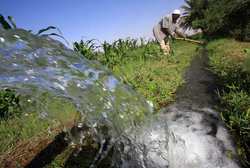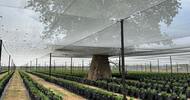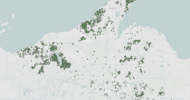The world’s population is soaring past 7 billion. Food prices keep spiking every few years. Freshwater supplies in plenty of areas are dwindling.
And so, in response, a slew of countries and investors — from Chinese state corporations to Gulf sheiks to Wall Street firms — have started buying up farmland overseas, in an apparent attempt to acquire as much precious soil and water as possible. This phenomenon is known as “land grabbing,” and it has been accelerating ever since the massive surge in grain prices back in 2007.
So how much land and water is actually being grabbed? Quite a lot, according to a big new study published in the “Proceedings of the National Academies of Sciences” this week. The authors find that somewhere between 0.7 percent and 1.75 percent of the world’s agricultural land is being transferred to foreign investors from local landholders. That’s an area bigger than France and Germany combined.
Big purchasers of foreign farmland include Britain, the United States, China, the United Arab Emirates, South Korea, South Africa, Israel, India and Egypt. They’re mostly seeking out land in Africa and Asia, particularly in countries such as Congo, Sudan, Indonesia, Tanzania, Mozambique, Ethiopia and even Australia.
Here’s a map from the PNAS study showing who’s grabbing what from where. Red triangles indicate investors, green dots indicate land that’s being snatched up. Note that some countries, like Russia and Brazil, are on both ends of the farmland trade:
The study found that foreign investors frequently buy tracts of land that have plenty of freshwater, either from local rainfall or underground aquifers. That’s the key commodity here. “This is often good agricultural land that isn’t yet fully utilized,” says Paolo D’Odorico, one of the study’s co-authors. “It was being used by local farmers without modern technology, without irrigation, without fertilizer.”
After the land is bought up, large commercial farms will move in and boost production to grow their own crops. One 2010 study from the World Bank found that about 37 percent of this “grabbed” land is used to grow food crops, 21 percent to grow cash crops and 21 percent to grow biofuels. (For instance, some 27,400 square miles of land land have been snatched up in Indonesia, largely to grow palm oil, which can be turned into biodiesel.)
Is this a problem? In the abstract, it doesn’t have to be — skilled foreign investors might be able to squeeze more use out of the land than the locals can. That could, in theory, be a mutually beneficial trade. But in practice, there are a lot of concerns about how all this land is actually being acquired.
Last year, for instance, Human Rights Watch released a report alleging that the Ethiopian government was forcibly relocating tens of thousands of people in order to lease land to foreign investors from China and he Gulf States. “The first round of forced relocations occurred at the worst possible time of year — the beginning of the harvest,” the report said. “Government failure to provide food assistance for relocated people has caused endemic hunger and cases of starvation.”
D’Odorico points out that a great deal of land and fresh water is also being bought up from poorer countries that are struggling to feed themselves, such as Tanzania. “If the food being produced on this land was going to locals instead of foreigners,” he points out, “it would be possible for countries like Tanzania to cut down substantially on malnourishment.”
Another example: The PNAS study notes that Sudan is leasing much of its prime farmland on the banks of the Blue Nile to foreign investors who are exporting food out of the country. Meanwhile, the rest of the people in this otherwise arid country have become increasingly dependent on food aid and subsidies.
There’s still an enormous amount that researchers don’t know about land-grabbing, according to D’Odorico. It took years of painstaking work just to assemble data on how much land and freshwater is actually being bought up abroad. And there are many basic things that researchers can’t yet detail, including where the crops grown on grabbed land actually go, or how much yields improve when foreign investors come in.
What is likely, however, is that land grabbing will become more popular in the years ahead — especially if more governments start getting nervous about securing food supplies. Fred Pearce, who recently investigated the phenomenon for his book “The Land Grabbers,” explained the upshot in an interview with the Guardian: “The net result is that poor farmers and cattle herders across the world are being thrown off their land. Land grabbing is having more of an impact on the lives of poor people than climate change.”
Further reading:
– The PNAS study on land grabbing, by Maria Cristina Rulli, Antonio Saviori, and Paolo D’Odorico. And here’s a press release.
– A related post: Where the world’s running out of fresh water, in one map.















